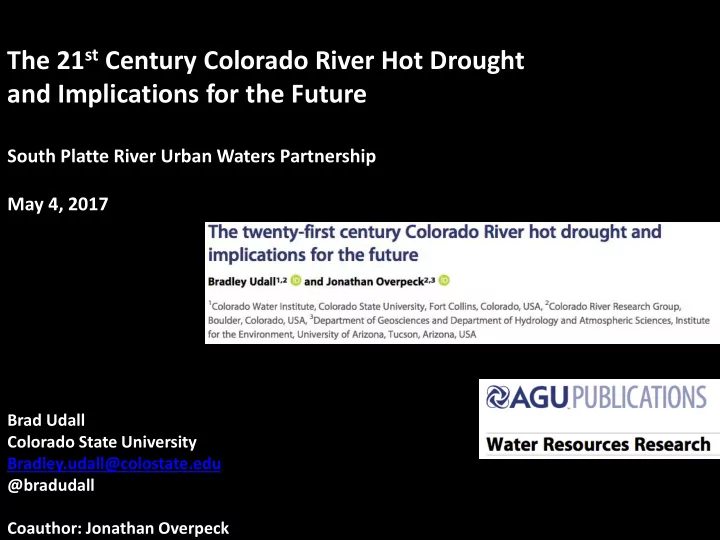

The 21 st Century Colorado River Hot Drought and Implications for the Future South Platte River Urban Waters Partnership May 4, 2017 Brad Udall Colorado State University Bradley.udall@colostate.edu @bradudall Coauthor: Jonathan Overpeck
May 3, 2017 CBRFC Forecast April – July runoff at 123% Past Forecasts: 3/1 = 145% 3/15 = 138% 4/1 = 130% 4/18 = 123% 5/03 = 123%
Calculated Temperature Sensitivity and Precipitation Elasticity with 6 different runoff models Temperature Sensitivity: Change in Flow per Degree Increase in Temperature. Is a Negative Percent Precipitation Elasticity: Percent Change in Flow per 1% Change in Precipitation. Is a unit-less number Temperature Sensitivity and Precipitation Elasticity are roughly additive
An interdisciplinary team reconciled the future of the Colorado River Warming alone will drive Colorado River flow declines of -6.5% +/- 3.5% per ºC Precipitation Elasticity at 2 to 3 Bulletin of the American Meteorological Society, January 2014 issue
Contents of the Two Largest Reservoirs in the United States 2000 = Full 2015 = ~ 40% Most Serious Drought since records kept Causes… Lake Powell: Drought Lake Mead: Structural Deficit (“overuse”)
Temperatures Key to 2000 s Decline 2000-14 Temperatures are 1.6 ° F above 1906-99 Average Temperature Sensitivity Explains 1/6 to ½ of the current runoff reduction. 1/3 is mid point of 1/6 and 1/2 Source: Udall & Overpeck 2017, PRISM Temperatures
Two Droughts – Two Different Causes 1953-1967 Drought - 18% Flow Decline - 6.1% Precipitation 2000-2014 Drought - 19% Flow Reduction - 4.6% Precipitation Note: 2000s Drought is only 75% of the Precipitation Decline in the 1950s Drought Source: Udall & Overpeck, 2017; flow data from Reclamation, PRISM Precipitation
How is atmospheric warming vaporizing our snow & water? Or… The warming atmosphere Where is the water from demands more moisture the Colorado River going?
How is atmospheric warming vaporizing our snow & water? Evapo- Positive transpiration feedbacks Sublimation from plants amplify these from snow impacts Where is the Longer water from growing the Colorado season for Rain melts vegetation snow River going? Evaporation of surface More rain water and less snow
The Upper Colorado River Basin is Megadrought Country – 1200 years of Colorado River flow thanks to tree rings Meko et al., ( Geopysical Research Letters , 2007)
Cook Science In both Central Plains and Southwest, Multi- Percent Chance decadal Drought Risk* of Multi- exceeds 80% in 21 st Decadal Century Drought Risk, Southwest US * Defined as Drought lasting 35 or more years
The Complete Picture… You have to invoke higher temperatures to explain the current drought. AND…. This does not bode well for the future… Source: Udall & Overpeck 2017
Colorado River Future Flow Losses Climate Change a combination of … 1. For-Sure Temperature Rise -> Flow Losses 2. Not-Sure Precipitation Change -> Flow Gains or Losses
Key Additional Points
Water Quality Implications • Lower Flows = Warmer Water – Stress on Aquatics • Ripple Effects – ESA Issues – Fires – Legal Winners and Losers
End
May 2015 was the country’s wettest May since records began 121 years ago. In fact, it was the wettest month ever recorded! https://www.climate.gov/news-features/featured- images/may-2015-was-wettest-month-ever-recorded-us
“The improved hydrology has changed the landscape and given us a reprieve,” said Suzanne Ticknor, CAP’s water-policy director Other water users disagree with this position, including the Arizona Department of Water Resources (DWR), the Tucson and Phoenix water utilities and the Gila River Indian Community, which controls the largest share of CAP water.
Science Advances (2015)
April 18, 2017 CBRFC Forecast April – July runoff at 123% Past Forecasts: 4/1=130%, 3/15= 138%, 3/1= 145%, 2/15= 137%, 2/1= 134%
Science, June 25, 2010 2F Warming since 1900 • • Snowpack Reductions and Changes in Runoff Timing Already Present • Most Severe Drought since records kept • Powell and Mead at 50% of capacity now, full 2000 • Tree Mortality Rates High • Increase in Wildfire Frequency • Drought may be natural, but exacerbated by higher temperatures • Snowpack Reductions and Runoff Timing attributed to climate change • Continued drying likely as temperatures increase and storm tracks shift • Megadroughts independent of climate change a possibility with severe consequences if combined with warming
California Winter 2014-2015 Drought • Winter Temperatures – Sierra Winter Above 32 F, 2013 (1 st time >32F in 120 years) – • Sierra Precipitation – Rain, not Snow – Not the driest! – (40% to 90% of normal) • Snowpack – Lowest Ever - 5% on April 1 – (1977 at 25%) – 500-Year (?) Return Period • Drought – Worst in 1200 (?) Years Water Deliveries • – Record Low to CVP Contractors 5’ Snow 2015 normally
Running dry: The U.S. Southwest's drift into a drier climate state 1980-2010 Weather Patterns that provide winter precipitation are becoming less frequent due to Hadley Cell Expansion. Southwest Precipitation has declined by 25%. Prein et al, 2016
• No change in precipitation over last few decades • But the occurrence of drought has increased in last two decades over previous century • The probability that precipitation deficits occur with warm temperatures has increased
Texas Floods April 15-19, 2016 Louisiana Floods August 8-14, 2016
Recommend
More recommend